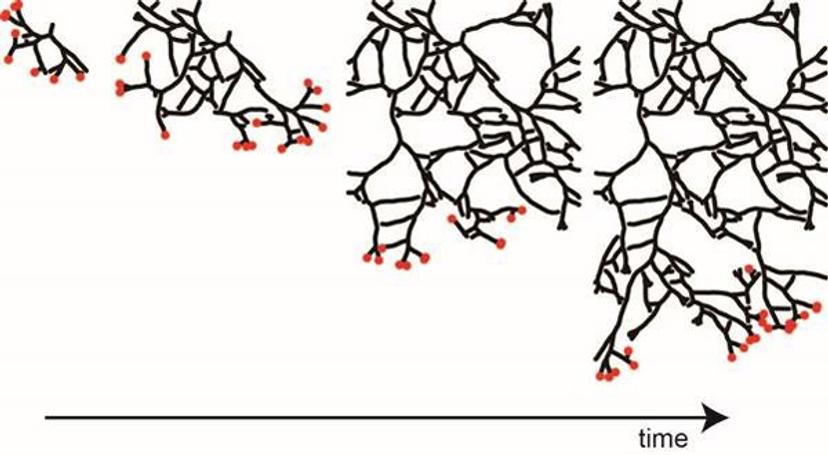Scientists Reveal the Beautiful Simplicity Underlying Branching Patterns in Tissue
Study led by Cambridge physicist offers surprisingly simple answer to question that has long confounded biologists
14 Sept 2017In the centenary year of the publication of a seminal treatise on the physical and mathematical principles underpinning nature – On Growth and Form by D’Arcy Wentworth Thompson – a Cambridge physicist has led a study describing an elegantly simple solution to a puzzle that has taxed biologists for centuries: how complex branching patterns of tissues arise.
Branching patterns occur throughout nature – in trees, ferns and coral, for example – but also at a much finer scale, where they are essential to ensuring that organisms can exchange gases and fluids with the environment efficiently by the maximising the surface area available.
For example, in the small intestine, epithelial tissue is arranged in an array of finger-like protrusions. In other organs, such as kidney, lung, mammary glands, pancreas and prostate, exchange surfaces are packed efficiently around intricate branched epithelial structures.
See our article detailing how Dr. Nicholas Zachos re-creates the gut epithelium in vitro >>
“On the surface, the question of how these structures grow – structures that may contain as many as 30 or 40 generations of branching – seems incredibly complex,” says Professor Ben Simons, who led the study, published in the journal Cell. Professor Simons holds positions in the University of Cambridge’s Cavendish Laboratory and Wellcome Trust/Cancer Research UK Gurdon Institute.
This classic problem of ‘branching morphogenesis’ has attracted the attention of scientists and mathematicians for centuries. Indeed, the mathematical underpinnings of morphogenesis – the biological process that causes organisms to develop their shape – was the subject of D’Arcy Wentworth Thompson’s classic text, published in 1917 by Cambridge University Press. Thompson had been a student at Cambridge, studying zoology at Trinity College, and briefly worked as a Junior Demonstrator in Physiology.
During development, branching structures are orchestrated by stem-like cells that drive a process of ductal growth and division (or ‘bifurcation’). Each subsequent branch will then either stop growing, or continue to branch again. In a study published in Nature earlier this year, Professor Simons working in collaboration with Dr Jacco van Rheenen at the Hubrecht Institute in Utrecht showed that, in the mammary gland, these processes of division and termination occur randomly, but with almost equal probability.
“While there’s a collective decision-making process going on involving multiple different stem cell types, our discovery that growth occurs almost at the flip of a coin suggested that there may be a very simple rule underpinning it,” says Professor Simons.
Professor Simons and his colleague Dr Edouard Hannezo observed that there was very little crossover of the branches – ducts seemed to expand to fill the space, but not overlap. This led them to conjecture that the ducts were growing and dividing, but as soon as a tip touched another branch, it would stop.
“In this way, you generate a perfectly space-filling network, with precisely the observed statistical organisation, via the simplest local instruction: you branch and you stop when you meet a maturing duct,” says Dr Hannezo, a Sir Henry Wellcome Postdoctoral Fellow based at the Gurdon Institute. “This has enormous implications for the basic biology. It tells you that complex branched epithelial structures develop as a self-organised process, reliant upon a strikingly simple, but generic, rule, without recourse to a rigid, pre-determined sequence of genetically programmed events.”

Although these observations were based on the mammary gland epithelium, by using primary data from Dr Rosemary Sampogna at Columbia University, Professor Anna Philpott in Cambridge and Dr Rakesh Heer at Newcastle University, the researchers were able to show that the same rules governed the embryonic development of the mouse kidney, pancreas and human prostate.
“In the mammary gland, you have a hundred or more fate-restricted stem-like cells participating in this bifurcation-growth-bifurcation process, whereas in the pancreas it’s just a handful; but the basic dynamics are the same,” says Professor Simons. “The model is aesthetically beautiful, because the rules are so simple and yet they are able to predict the complex branching patterns of these structures.”
The researchers say their discovery may offer insights into the development of breast and pancreatic cancer, where the earliest stages of the disease often show an irregular tangled ductal-like organisation.
“A century after the publication of On Growth and Form, it’s exciting to see how the concepts of self-organisation and emergence continue to offer fresh perspectives on the development of biological systems, framing new questions about the regulatory mechanisms operating at the cellular and molecular scale,” Professor Simons adds.
While it may be too early to tell whether similar rules apply to other branched tissues and organisms, there are interesting parallels: branching in trees appears to follow a similar pattern, for example, with side branches growing and bifurcating until they are shaded or until they are screened by another branch, at which point they stop.
The research was funded by the Wellcome Trust with additional core support from Cancer Research UK and the Medical Research Council.
Dr Sheny Chen from Wellcome’s Cellular and Developmental Science team, said: “This is an elegant study that helps us to understand what guides the decisions our cells make during essential developmental processes. It’s fascinating to see that such simple rules can govern the generation of such highly complex patterns and that these rules can apply to different branched structures.”
References
Hannezo, E et al. A unifying theory of branching morphogenesis. Cell; e-pub 14 Sept 2017; DOI: TBC
